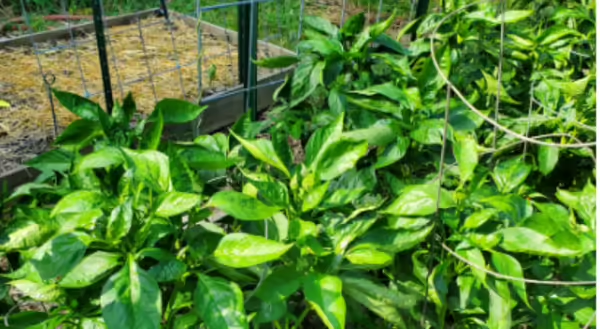
At this point in the growing season, ripe produce is typically coming out of the vegetable garden daily since most warm-season crops are in full swing. From ripe tomatoes and peppers to the many cucurbits in peak production right now, the early-season work to establish and care for these plants is paying off. However, when this work doesn’t pay off in the harvest, gardens can often have a perplexing puzzle to sort out.
In recent weeks, I have assessed several bell pepper patches with relatively no fruit. The pepper plants themselves seemed to be thriving, with lush and healthy canopies of large green leaves — but simply no fruit. In these cases, there may be several issues at play, requiring gardeners to do some detective work.
Pepper Fertilization
One commonly relayed reason for poor fruit set in otherwise healthy and thriving pepper plants is overfertilization. While this does make sense in cases where excess nitrogen fertilizer was applied, since nitrogen is mostly responsible for leafy, green growth, university recommendations and research do not substantiate this idea. In fact, peppers have been shown to produce similar quality and quantity of fruits despite varying fertilizer inputs.
When pepper plants have spent little energy on fruit production thus far in the growing season, they typically have excess energy to put into leaf and stem growth, producing large and healthy plants with no fruits.
The bottom line is that overfertilization doesn’t cause a lack of fruit, and pepper plants benefit little from excess fertilizer. Since over-application of fertilizer can result in water pollution, as well as increasing the footprint of your production system, it’s important to follow fertilization instructions and apply recommended amounts. For fertilizer recommendations, please visit go.illlinois.edu/Peppers.
Pepper Pollination
Evidence from research suggests that pollination may be a big factor in cases of poor fruit set. The basic structure of pepper flowers supports this conclusion since the timing and onset of male versus female flower parts suggest that insect pollination may play a role. In addition, bell pepper flowers produce nectar, a key food source for many pollinators, which is energy-intensive for the plant and typically not done unless necessary.
While pepper plants do self-pollinate, their pollination rate and overall production have been shown to be enhanced by pollinators. In one study, conducted in greenhouses, bumblebee-pollinated plants were compared to self-pollinated plants, and researchers found larger, more abundant fruits with more seeds on plants that were bee-pollinated. Other work has also substantiated these findings, drawing a consistent connection between insect pollination and larger fruits with more seeds.
All of this evidence builds an even stronger case for planting a thriving pollinator garden near your veggie patch. In addition to bees, pepper flowers attract moths and butterflies, so consider adding more plants that attract all of these pollinator groups to maximize pollination and subsequent fruit production.
What About Flower Drop?
Flower drop prior to pollination is a common problem in peppers as well. Various research has looked at flower drop and the factors surrounding it, with most studies concluding that higher temperatures cause increased flower loss. One study that is often cited from 2002 found that flower set was significantly impacted at temperatures above 91 F.
My own pepper plants had abundant flowers in mid-June. However, the late June and early July weather was exceptionally hot, reaching near 90°F many days. Keep in mind that it often takes over 45 days to produce a ripe pepper after flowers are pollinated. Flowers from late June should be maturing soon, depending on the variety. A plant with no fruit now may have lost flowers back in June or early July.
Even if your plants don’t appear to have many fruits now, inspect them for tiny, maturing flowers. It’s a good bet that our cooler streak back in July brought on a healthy crop of flowers, even if the late-June heat caused some flower drop. Don’t lose hope on harvesting fresh peppers yet this year, they are likely on the way!
About the Author
Ryan Pankau is Horticulture Extension Educator with University of Illinois Extension serving Champaign, Ford, Iroquois, and Vermilion Counties.